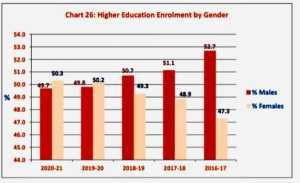Average Annual Growth Rate in Muslim Enrolment in Higher Education, 2016-17 to 2020-21
The data presented in Table 32 on the Average Annual Growth Rate (AAGR) in enrolment at the higher education level from 2016-17 to 2021-22 provides valuable insights into the progress and areas of focus for policymakers and stakeholders. The AAGR for Muslim enrolment at this level has increased at a lower rate than the total enrolment, consistent for both male and female students.
The specific AAGR for Muslim enrolment during the specified period is as follows:
- Male: 1.03 percent
- Female: 4.12 percent
- Both (Male & Female): 2.53 percent
The data indicate that female Muslim students have experienced a significantly higher AAGR than their male counterparts, suggesting that efforts to improve access and participation of Muslim women in higher education have been relatively successful. This trend reflects an increasing inclination towards higher education among Indian women, which may be attributed to awareness campaigns, scholarships, and initiatives promoting gender equality in education. The higher growth rate for females signifies an encouraging stride towards bridging the gender gap in higher education.
Analyzing the average annual rate of growth in enrolment at the higher education level in India reveals some critical implications:
- Gender Disparities: The significant difference in growth rates between male and female enrolment, particularly among Muslim students, highlights the need for targeted efforts to address gender disparities in higher education. Implementing initiatives targeting male students and creating an inclusive environment for both genders can help reduce this disparity and ensure equal access to educational opportunities.
- Empowering Muslim Women: The higher AAGR of female Muslim enrolment indicates the potential for educational empowerment among Muslim women. It calls for sustained efforts to provide equal opportunities, scholarships, and support systems to encourage more female Muslim students to pursue higher education and enable them to contribute actively to society and the economy.
- Continued Focus on Total Enrolment: While the AAGR in total enrolment is positive, there is room for further improvement. Policymakers should continue focusing on expanding access to higher education, improving the quality of education, and addressing socio-economic barriers that may hinder students’ participation in higher education.
By addressing these implications and building on the progress made, India can continue to advance its efforts in promoting inclusive and equitable higher education. Encouraging higher enrolment rates, particularly among underrepresented groups like Muslim women, will contribute to a more diverse and skilled workforce, driving the country’s social and economic development.
Table 32: Average Annual Growth Rate in Enrolment at Higher Education Level
All India: 2016-17 to 2021-22
|
|
Average Annual Growth Rate (%) |
||
| Male | Female | Both | |
| Muslim Enrolment | 1.03 | 4.12 |
2.53 |
|
Total Enrolment |
2.85 | 4.76 |
3.76 |
The analysis of the average annual enrollment growth rate at the higher education level in India presents a complex scenario. On the one hand, the overall growth rates indicate progress in the education sector. However, on the other hand, the data highlights the urgent need for targeted interventions to address gender disparities and foster inclusivity. The encouraging aspect of the data lies in the higher growth rate among female students, including those from the Muslim community, which reflects the positive impact of initiatives aimed at promoting gender equality in education. This signifies that efforts to empower women to access higher education yield fruitful results.
Policymakers and educational institutions must build upon these promising findings and continue their efforts to create a more equitable and inclusive higher education system in India. Focusing on targeted measures that address gender-based barriers and foster inclusivity can bridge the existing gaps and ensure that every individual, regardless of gender or background, has equal opportunities to access and thrive in higher education.
When we delve into the Gross Enrolment Ratio at the higher education level, more insights into the situation of Muslims in higher education come to light. This broader perspective will enable a more comprehensive understanding of the challenges various communities face, including Muslims, and guide policymakers in crafting effective strategies to foster education among all sections of society. Ultimately, a concerted effort towards promoting inclusivity, gender equality, and access to education will benefit individuals and contribute to the nation’s overall socio-economic development.
Muslim Gross Enrolment Ratio at School Education in India (2021-22)
State-wise Muslim Gross Enrolment Ratio at School Education in India (2021-22)
Muslims Gross Enrolment Ratio at Higher Education Level (2020-21)
Muslim Gender Parity Index at Higher Education Level in India, 2016-17 to 2020-21
Share of Muslim Enrolment at School to Higher Education Level





